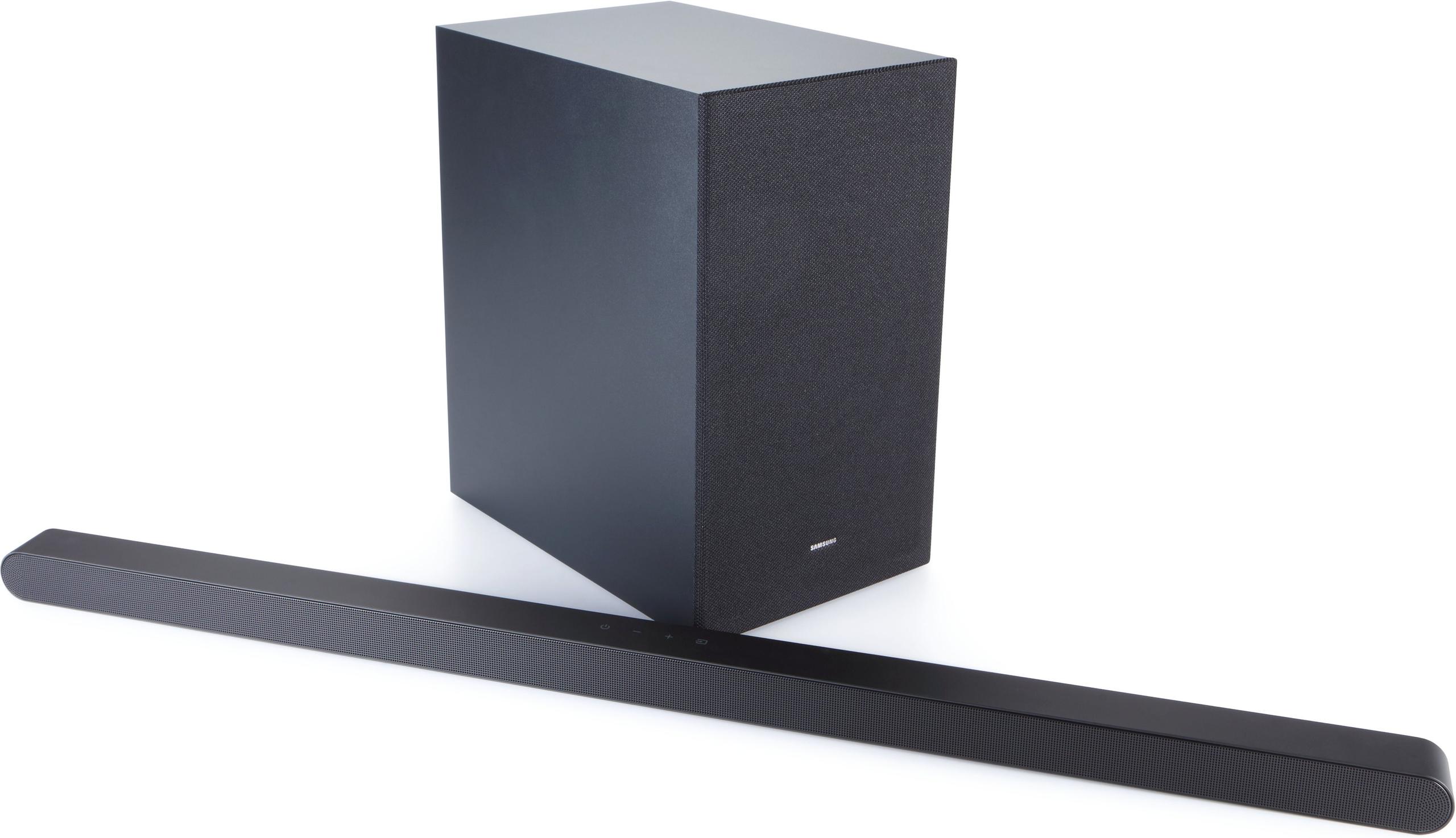 Samsung HW-S700D 3.1 Channel Slim Soundbar
Samsung HW-S700D 3.1 Channel Slim Soundbar

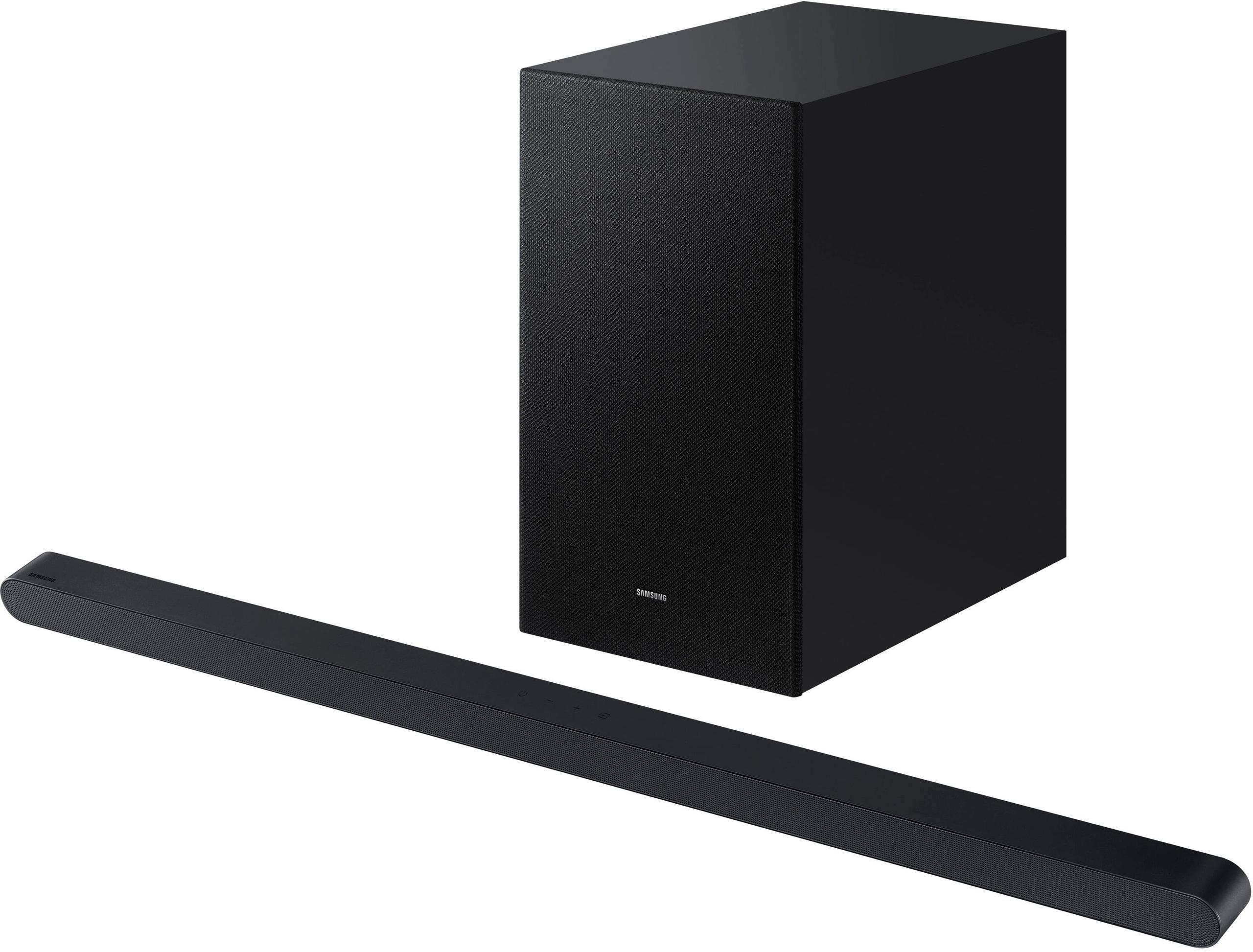
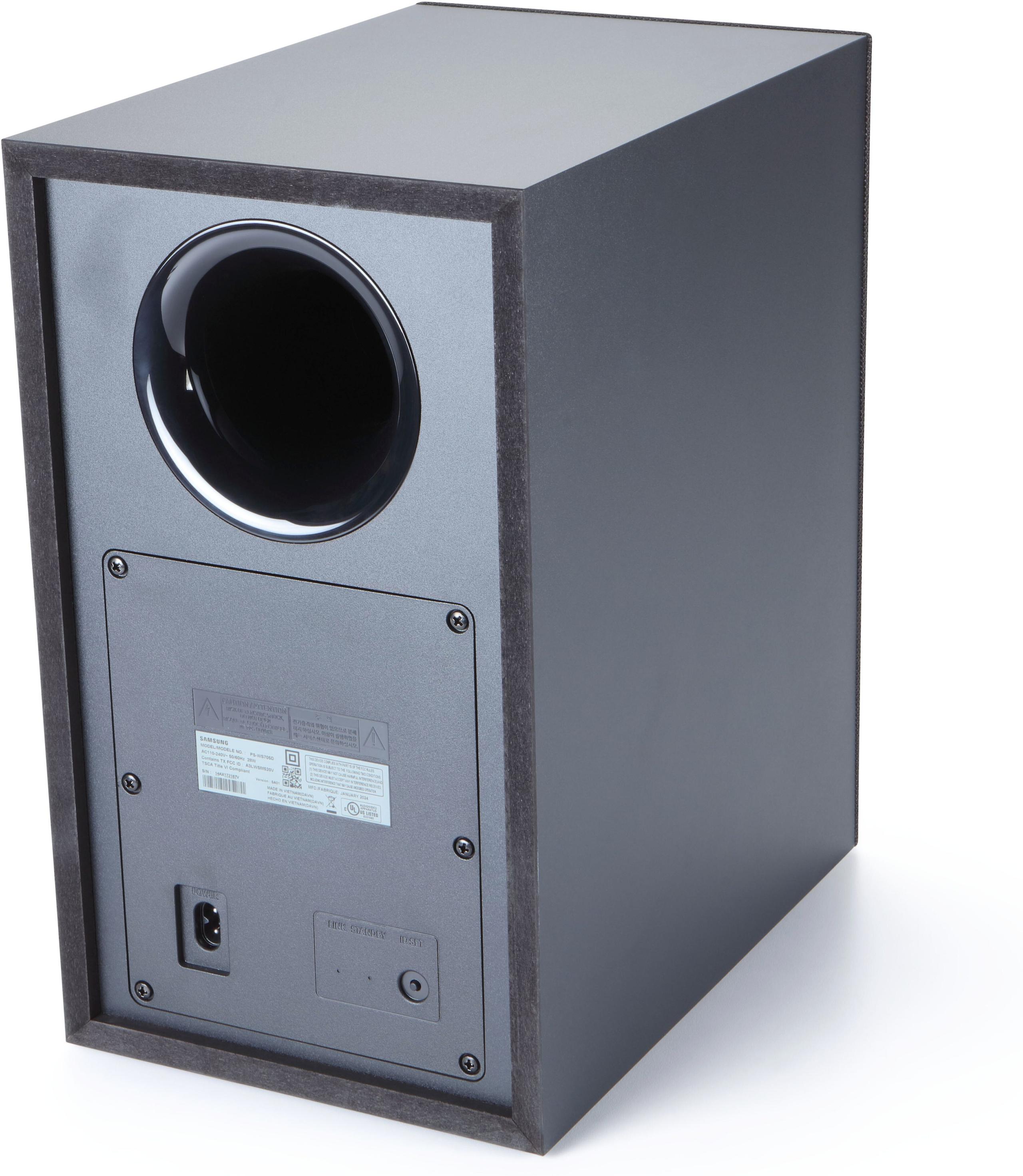
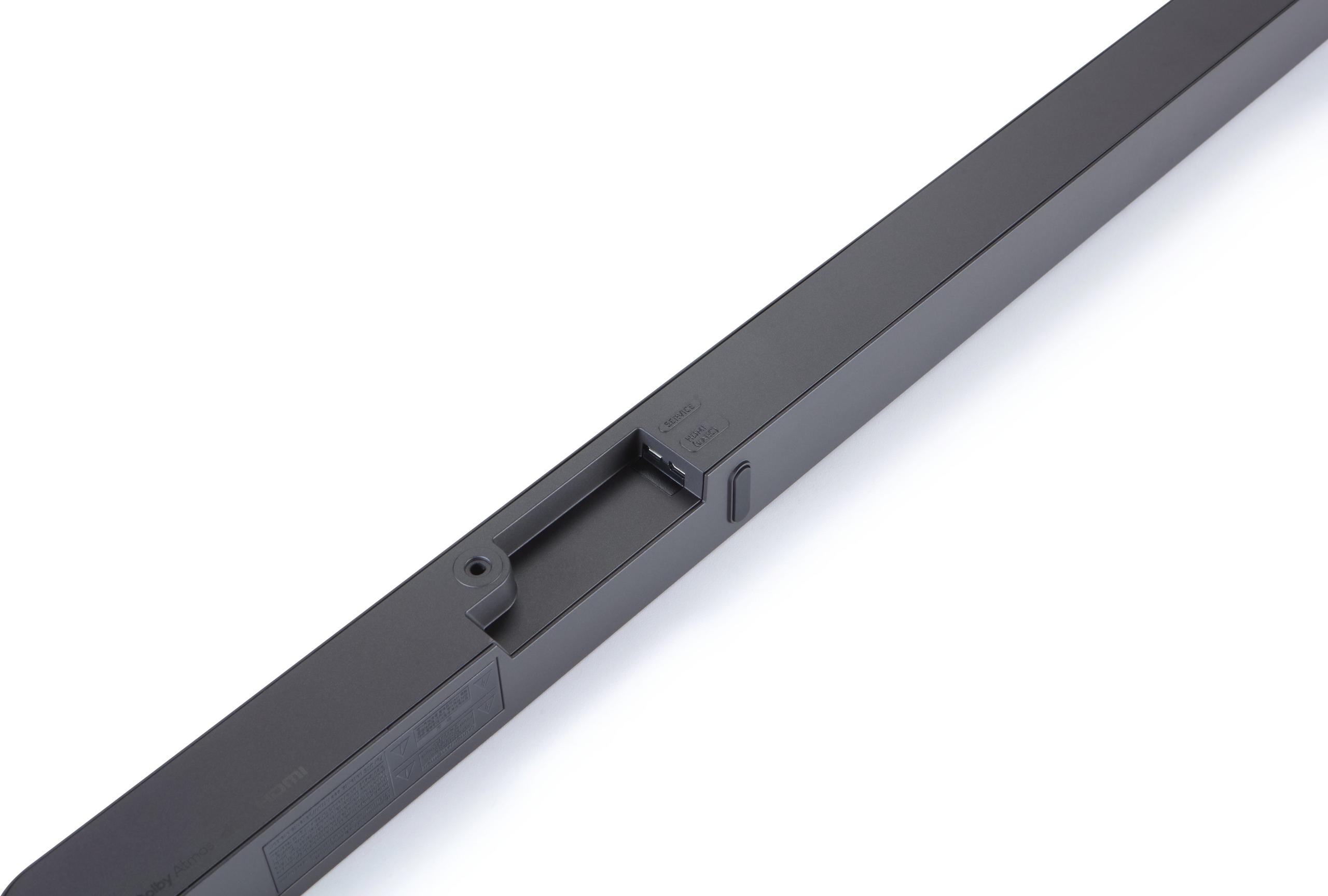

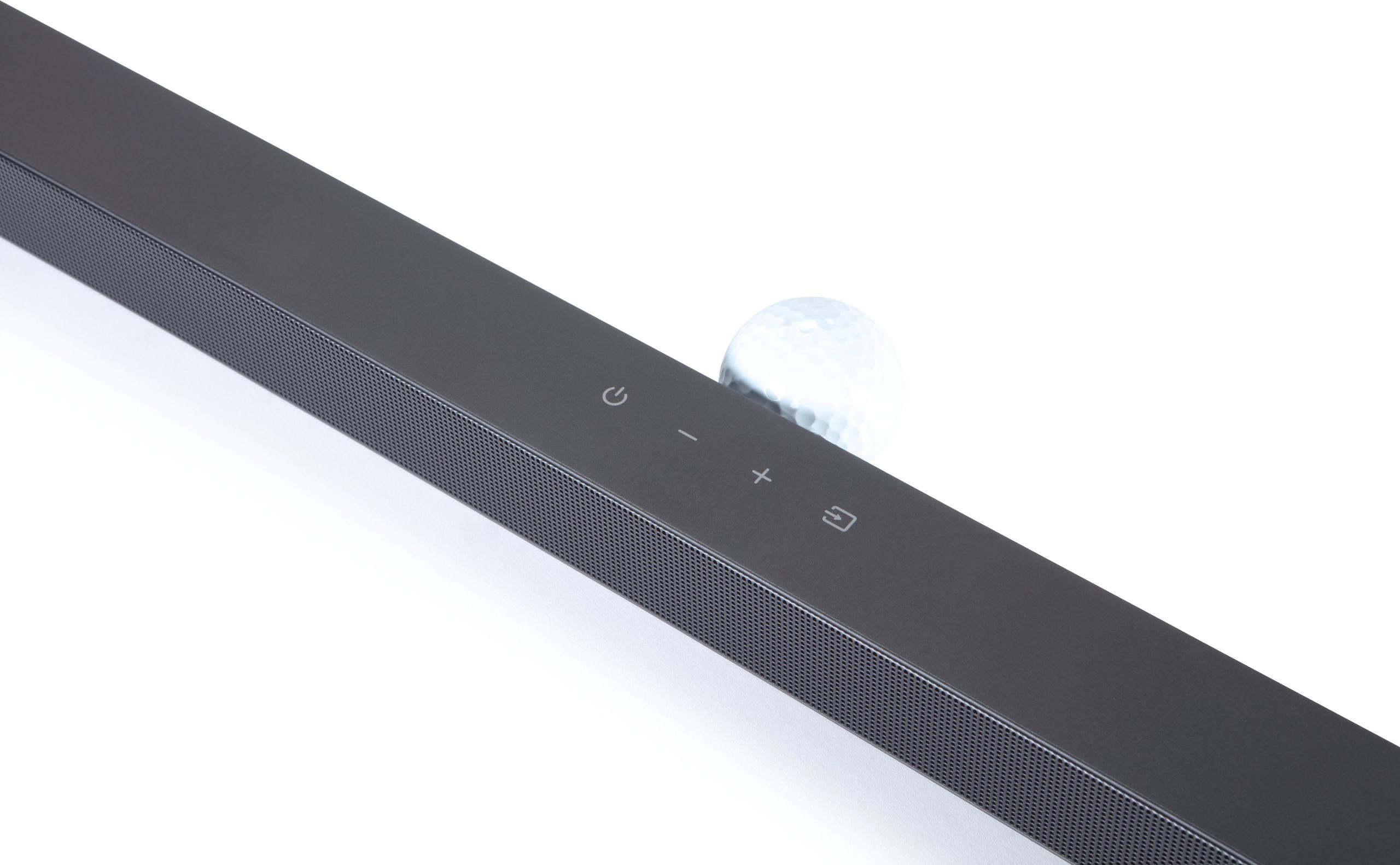

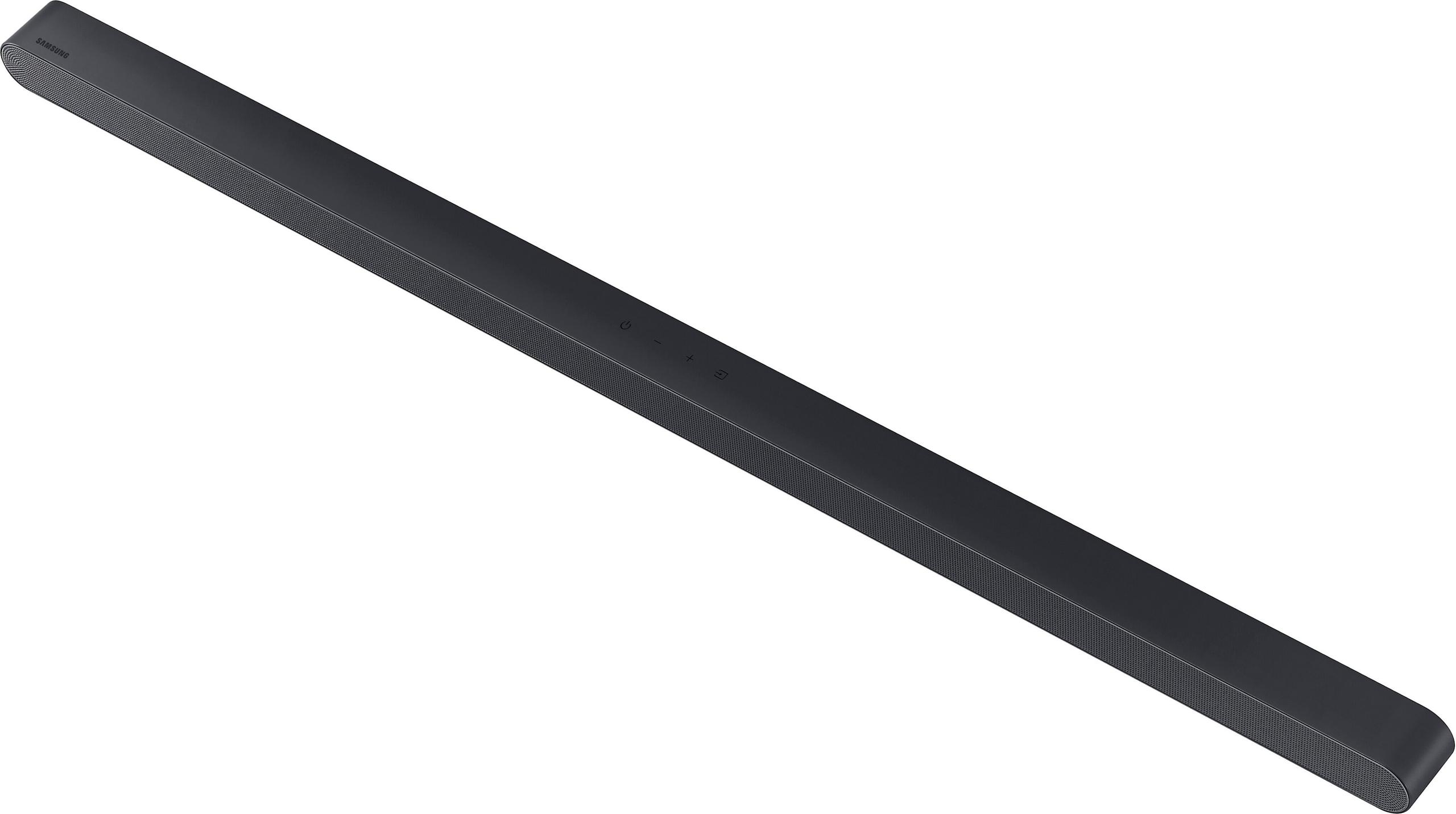


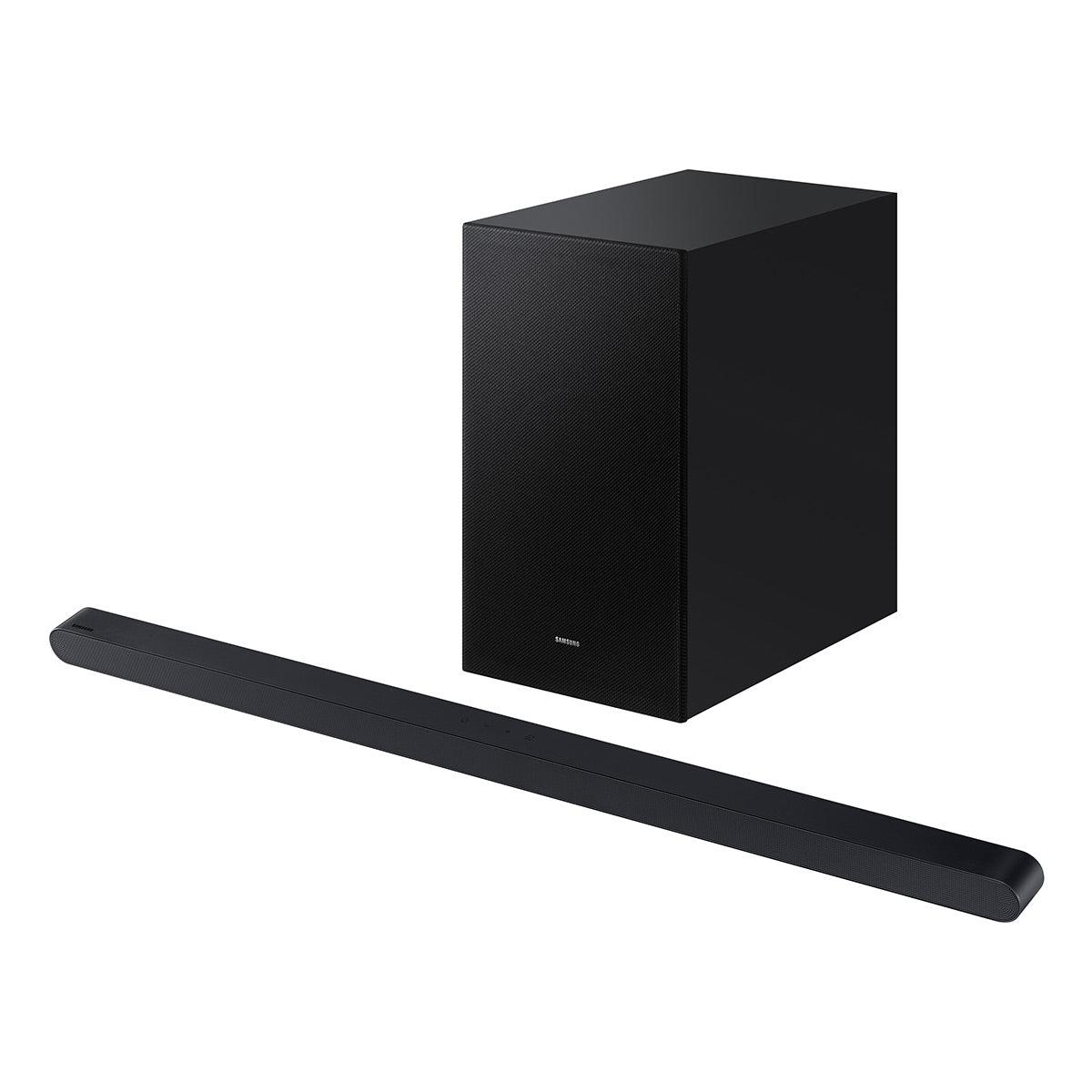
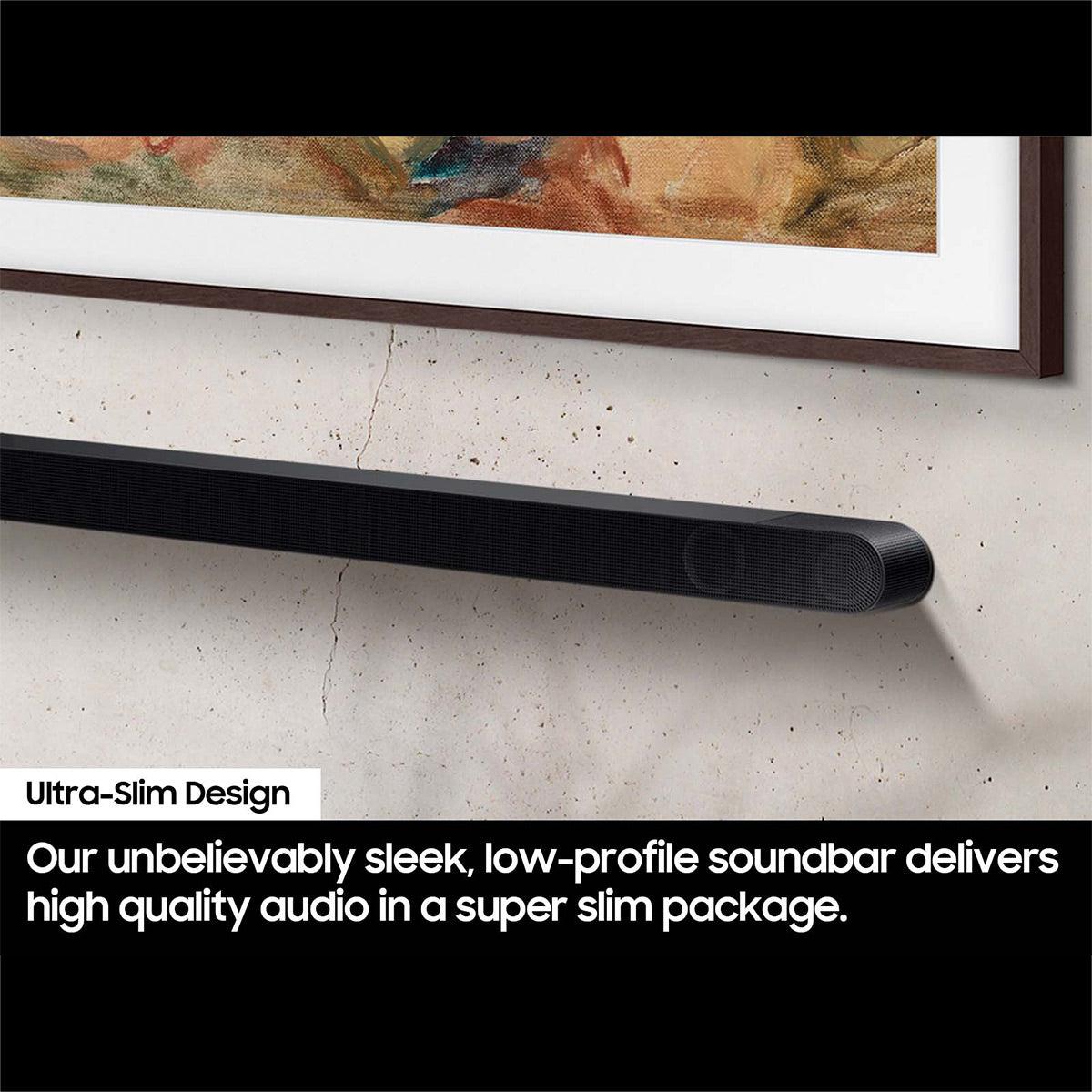












$499.99 Original price was: $499.99.$265.00Current price is: $265.00.
Samsung HW-S700D ($449-499)
Released in mid-2023, Samsung's slim soundbar represents their latest push to balance performance and aesthetics. After spending several weeks testing it in different room configurations, it's clear this model targets a sweet spot in the market.
Soundbars have come a long way from simple TV speaker replacements. Today's models, like the HW-S700D, pack sophisticated audio processing and smart features into increasingly compact designs. The key advancement this year is wireless audio quality - Bluetooth 5.2 and improved wireless Dolby Atmos support show how far we've come from the compressed audio of early soundbars.
The first thing you'll notice is how slim this unit actually is. At just over 2 inches tall, it's remarkably unobtrusive under most TVs. During our testing, it disappeared visually beneath a 65" Samsung TV while still delivering room-filling sound.
Setup is straightforward:
The 3.1 channel configuration might seem basic compared to 7.1 systems, but Samsung's implementation impressed us in testing. Here's why:
The dedicated center channel makes a noticeable difference. Watching dialogue-heavy shows like "The Crown," voices remained clear and natural even during busy scenes. The Active Voice Amplifier (AVA) technology actively monitors ambient noise and adjusts dialogue levels accordingly - particularly useful when running appliances or during noisy scenes.
The wireless subwoofer packs a 6-inch driver that delivers surprising punch for its size. In our testing room (16x20 feet), it provided ample low-end without overwhelming the space. The bass remained tight and controlled rather than boomy, which we appreciate for both movies and music.
While not a true surround system, several technologies work together to create a convincing soundstage:
The HW-S700D shines in its integration of modern conveniences:
Works with:
Game Mode Pro deserves special mention. It enhances directional audio cues and reduces latency - crucial for competitive gaming. We tested this with both PS5 and Xbox Series X, noting improved spatial awareness in first-person shooters.
For home theater enthusiasts, several factors make this soundbar worth considering:
At $449-499, the HW-S700D sits in the competitive mid-range segment. Compared to 2022 models, you're getting:
The value proposition is strongest for:
In our extended testing, several scenarios stood out:
The soundbar excelled with both action and dialogue. During dynamic scenes in "Dune," the system maintained clarity while delivering impactful bass. The night mode proved effective for late-night viewing, compressing dynamic range without sacrificing detail.
Music performance surprised us. The system handled various genres well, from classical to hip-hop. The 7-band EQ allows useful customization, though the default tuning is quite good.
Game Mode Pro noticeably improved spatial awareness in games like Call of Duty. The reduced audio latency was particularly noticeable in rhythm games.
Compared to previous models, Samsung has improved:
The Samsung HW-S700D represents a thoughtful balance of features, performance, and design. While not the most powerful soundbar available, it delivers where it matters most: clear dialogue, immersive sound, and easy integration into modern homes.
For most users, especially those with Samsung TVs, it offers excellent value. The combination of slim design, smart features, and solid audio performance makes it a compelling choice in the mid-range segment.
Best suited for:
Consider alternatives if you:
After extensive testing, we're confident recommending the HW-S700D for users seeking premium sound without complicated setup or compromised aesthetics. It's a refined product that shows how far soundbar technology has evolved, particularly in wireless audio quality and smart integration.
The Samsung HW-S700D ($449-499) offers excellent value for its price point, especially for Samsung TV owners. With features like wireless Dolby Atmos, Q-Symphony, and a slim profile, it's worth the investment for those seeking quality home theater audio without a complex setup. The dedicated center channel and room calibration make it particularly valuable for movie watching.
The soundbar excels at movie playback thanks to its 3.1 channel configuration and dedicated center channel. Dialog remains clear and crisp, while the wireless subwoofer provides impactful bass for action scenes. When paired with a Samsung TV, wireless Dolby Atmos adds an extra dimension to the viewing experience.
Yes, the HW-S700D works with any TV that has HDMI ARC/eARC or optical connections. However, premium features like Q-Symphony and wireless Dolby Atmos only work with compatible Samsung TVs.
Yes, the soundbar comes with wall-mounting hardware included. Its slim 2.1-inch height makes it ideal for wall mounting without protruding too far from the wall.
Setup is straightforward - connect via HDMI eARC, and the wireless subwoofer pairs automatically. Samsung TV owners can use the SmartThings app for additional setup options and controls.
Yes, the soundbar supports multiple streaming options including Bluetooth 5.2, Apple AirPlay 2, and Chromecast built-in. This makes it versatile for both home theater and music playback.
The included wireless subwoofer with 6-inch driver provides robust bass that works well for both movies and music. It's particularly impressive given the system's compact size and works well in medium-sized rooms.
While the HW-S700D is a 3.1 channel system, it's not designed to add rear speakers. For those wanting true surround sound, you might need to consider other models.
Yes, the soundbar is compatible with both Amazon Alexa and Google Assistant, allowing for voice control of basic functions and integration with smart home setups.
The soundbar includes Game Mode Pro, which enhances directional audio and reduces latency. This makes the HW-S700D a solid choice for gaming, especially when paired with a Samsung TV for optimal compatibility.
We've done our best to create useful and informative comparisons to help you decide what product to buy. Our research has used advanced automated methods to create this comparison and perfection is not possible - please contact us for corrections or questions. These are the sites we've researched in the creation of this article: crutchfield.com - samsung.com - bestbuy.com - avsforum.com - walts.com - samsung.com - samsung.com - videoandaudiocenter.com - samsung.com - samsung.com - samsung.com - pcrichard.com
| Samsung HW-S700D ($449-499) |
|---|
| Channels - Determines speaker configuration and sound separation: 3.1 channels |
| Wireless Subwoofer Size - Affects bass depth and impact: 6-inch driver |
| Dolby Atmos Support - Enables overhead sound effects: Yes (Wireless with Samsung TVs) |
| HDMI Ports - Important for connecting multiple devices: 1x eARC port |
| Bluetooth Version - Better version means improved wireless audio: 5.2 |
| Power Output - Determines maximum volume and headroom: 320W total system power |
| Room Calibration - Optimizes sound for your space: SpaceFit Sound Pro with built-in mic |
| Voice Enhancement - Crucial for clear dialogue: Active Voice Amplifier (AVA) + Center Channel |
| Gaming Features - Reduces audio lag and enhances directional sound: Game Mode Pro |
| Streaming Support - Enables wireless music playback: AirPlay 2, Chromecast, Bluetooth |
| Height - Critical for TV placement clearance: 2.1 inches |
| Width: 43.3 inches |
| Depth: 2.4 inches |
| Weight: 13.2 lbs |
| Wireless Connectivity: Wi-Fi, Bluetooth 5.2 |
| Voice Assistant Compatibility: Alexa, Google Assistant |
The Samsung HW-B550D ($177.99) offers impressive value by delivering core soundbar features without the premium price tag. While it lacks Dolby Atmos support, its DTS Virtual:X processing still creates convincing surround effects, and the dedicated center channel ensures clear dialogue reproduction. The included 5-inch wireless subwoofer provides solid bass response that's more than adequate for small to medium-sized rooms. For users who primarily watch regular TV content and movies without Atmos soundtracks, the real-world performance difference may be less noticeable than the price gap suggests.
At $220 less than the S700D, the HW-B550D makes some understandable compromises. It lacks room calibration features, smart home integration, and the ability to add wireless rear speakers later. The standard height profile may not be as aesthetically pleasing for wall-mounted setups, and Samsung TV owners won't get the benefits of Q-Symphony integration. However, its straightforward setup and operation, combined with good audio performance for both movies and music, make it an excellent choice for users who want significantly better sound than their TV speakers without investing in premium features they may not need.
🤖 Read Detailed Comparison
👌Samsung HW-B550D 3.1 Channel Sound Bar Details
💵 See Samsung HW-B550D 3.1 Channel Sound Bar Price
The Bose Solo Series 2 positions itself as a straightforward, budget-friendly alternative at $179.99, focusing on simplicity and ease of use rather than advanced features. Its 2.0 channel configuration and compact design make it particularly suitable for smaller rooms and basic TV audio enhancement needs. While it lacks a dedicated center channel and subwoofer, Bose's audio processing technology still manages to deliver clear dialogue and balanced sound that significantly improves upon built-in TV speakers. The simple optical connection and basic remote control mean setup takes just minutes, making it an attractive option for users who want a no-fuss solution.
Where the Bose Solo Series 2 falls short is in its limited expandability and feature set. The absence of HDMI connectivity, advanced audio processing, and room correction features means you won't get the same immersive experience or future upgrade potential. However, for users with smaller spaces or those primarily watching news, sports, and regular TV programming, these limitations may not be significant drawbacks. The Bose offers solid value for basic audio enhancement needs, though it won't deliver the same impact in movie scenes or music playback that you get with the Samsung's dedicated subwoofer and more advanced channel configuration.
🤖 Read Detailed Comparison
👌Bose Solo Soundbar Series 2 Soundbar Details
💵 See Bose Solo Soundbar Series 2 Soundbar Price
The $999.99 Sony HT-A8000 takes a notably different approach to home theater audio with its 5.0.2 channel configuration and sophisticated 360 Spatial Sound Mapping technology. Where Samsung focuses on slim design and value, Sony delivers a more premium experience with 11 separate speaker units and advanced room calibration features. The built-in dual subwoofers and dedicated height channels create a more immersive soundstage, particularly noticeable during movie playback. Sony's Sound Field Optimization uses microphone-based calibration to adapt the audio output to your specific room characteristics, resulting in more precise sound positioning.
While the Sony costs more than twice as much as the Samsung, it justifies its premium price with superior audio processing and better native bass response. The HT-A8000 particularly shines in larger rooms and dedicated home theater spaces where its additional channels and power output make a real difference. However, its larger physical presence and higher price point may be overkill for smaller spaces or casual TV viewing. The Sony also offers more expansion options with compatible rear speakers and subwoofers, though these additions push the total cost significantly higher.
🤖 Read Detailed Comparison
👌Sony HT-A8000 BRAVIA Theater Bar 8 Soundbar Details
💵 See Sony HT-A8000 BRAVIA Theater Bar 8 Soundbar Price
The Samsung HW-Q800D stands out with its more robust 5.1.2 channel configuration, offering a notably more immersive sound experience through additional surround channels and dedicated upward-firing speakers. While it commands a higher price point at around $699-799, the enhanced audio performance justifies the premium for serious home theater enthusiasts. The larger 8-inch subwoofer delivers deeper, more impactful bass, and the additional HDMI input provides more flexibility for complex setups. Perhaps most importantly, it supports wireless rear speaker expansion, allowing users to build a more complete surround sound system over time.
For those deciding between these two soundbars, the choice largely comes down to room size and primary use case. While both offer excellent dialogue clarity and core features like Q-Symphony and SpaceFit Sound Pro, the HW-Q800D is better suited for larger rooms and more demanding applications like action movies and gaming. Its Game Mode Pro feature and superior spatial audio make it particularly compelling for gaming enthusiasts. However, it's worth noting that this enhanced performance comes with a larger physical footprint that may not suit minimalist setups where the S700D's ultra-slim design excels.
🤖 Read Detailed Comparison
👌Samsung HW-Q800D 5.1.2 Channel Soundbar Details
💵 See Samsung HW-Q800D 5.1.2 Channel Soundbar Price
The Sonos Arc Ultra ($999) takes a notably different approach with its premium 9.1.4 channel configuration and sophisticated Sound Motion driver technology. While it commands a significantly higher price point, it delivers superior sound staging and music reproduction that justify the investment for audiophiles and home theater enthusiasts. The Arc Ultra's platform-agnostic design and extensive multi-room capabilities make it more versatile for whole-home audio integration, though it requires additional investment for a subwoofer and rear speakers to reach its full potential.
When comparing real-world performance, the Arc Ultra creates a more expansive and precise soundstage, particularly noticeable in complex movie soundtracks and music playback. Its Trueplay room calibration and more advanced Dolby Atmos implementation deliver a more immersive experience, especially in larger rooms. However, these advantages come at a significant price premium, and for many users, especially those primarily focused on TV viewing and basic surround sound, these enhancements may not justify the additional cost over the Samsung's more budget-friendly but still capable performance.
🤖 Read Detailed Comparison
👌Sonos Arc Ultra Dolby Atmos Soundbar Details
💵 See Sonos Arc Ultra Dolby Atmos Soundbar Price
The LG S90TR ($799) takes a different approach with its full 7.1.3 channel configuration, offering true surround sound through dedicated rear speakers and height channels for Dolby Atmos effects. This creates a more immersive home theater experience, with sounds that genuinely move around and above you rather than being simulated. The larger subwoofer and additional channels deliver more powerful bass and clearer separation between audio elements, which becomes particularly noticeable during complex movie scenes or when listening to high-quality music.
While the LG commands a higher price point, it justifies the premium for users seeking a more theater-like experience. However, it requires more space and setup consideration than the Samsung, with rear speakers needing proper placement and power connections. The LG S90TR also offers additional features like Chromecast support, AI room calibration, and WOW Orchestra integration with LG TVs. For those with the budget and space who prioritize immersive audio, particularly for movies and gaming, the LG's superior channel separation and true surround capabilities make it a worthwhile upgrade over virtual surround solutions.
🤖 Read Detailed Comparison
👌LG S90TR 7.1.3 Channel Soundbar with Wireless Subwoofer and Rear Speakers - Soundbar Details
💵 See LG S90TR 7.1.3 Channel Soundbar with Wireless Subwoofer and Rear Speakers - Soundbar Price
The LG S95TR ($999.99) stands out with its comprehensive 9.1.5 channel configuration, offering a significantly more immersive audio experience through true Dolby Atmos support and dedicated rear speakers. While it commands a higher price point, this premium soundbar delivers theater-like surround sound with five up-firing speakers that create genuine overhead effects. The inclusion of wireless rear speakers and an 8-inch subwoofer provides deeper bass and more precise spatial audio positioning, making it particularly compelling for serious home theater enthusiasts and gamers who want to hear every detail in their content.
However, this enhanced performance comes with additional complexity in setup and room requirements that the Samsung doesn't demand. The LG system requires more space for optimal speaker placement and multiple power outlets for the satellite speakers. While it offers superior audio quality and more features, the value proposition really depends on your room size and how much you prioritize immersive sound. For larger rooms and dedicated home theater spaces, the extra investment in the LG S95TR delivers noticeable benefits, but it may be overkill for smaller spaces or casual viewing environments where the Samsung's simpler setup could be more practical.
🤖 Read Detailed Comparison
👌LG S95TR 9.1.5 Channel Soundbar with Dolby Atmos Soundbar Details
💵 See LG S95TR 9.1.5 Channel Soundbar with Dolby Atmos Soundbar Price
For those seeking maximum home theater immersion, the Samsung HW-Q990D ($1,999) represents a significant step up in both capability and price. Its 11.1.4 channel configuration, including dedicated rear speakers and four up-firing channels, creates a truly enveloping sound experience that the S700D simply can't match. The additional channels and speakers make a noticeable difference when watching movies or gaming, placing sounds precisely around and above you. While it requires more space and setup consideration, the Q990D delivers audio quality that rivals traditional component home theater systems costing considerably more.
The Samsung HW-Q990D also brings additional premium features like advanced gaming support with 4K/120Hz passthrough, VRR, and enhanced Game Mode Pro settings. The inclusion of two HDMI inputs provides more flexibility for connecting multiple devices directly to the soundbar. While the five-times-higher price point represents a significant jump, the performance difference is immediately noticeable, particularly for movie enthusiasts and gamers who want the most immersive audio experience possible. However, this level of performance is best realized in medium to large rooms where the system has space to properly create its surround sound field.
🤖 Read Detailed Comparison
👌Samsung HW-Q990D 11.1.4 Channel Sound Bar Details
💵 See Samsung HW-Q990D 11.1.4 Channel Sound Bar Price
The Samsung B-Series 5.1 Channel Soundbar ($348) offers a more traditional home theater approach at a lower price point. Its standout feature is the true 5.1 channel configuration with included wireless subwoofer, delivering more convincing surround sound and deeper bass response out of the box. While it lacks some of the premium processing features, the B-Series compensates with genuine rear channel effects and powerful bass impact that make movies and games more immersive. DTS Virtual:X technology provides decent height effects, and the Bass Boost mode offers satisfying low-end performance for music.
Cost-conscious buyers will appreciate that the B-Series delivers a complete surround sound solution for $150 less than the S700D. Though it requires more space due to the separate subwoofer and has a more conventional design, the performance benefits are tangible - especially for movie watching and gaming. The primary tradeoffs are the lack of advanced room correction, more basic TV integration features, and a larger physical footprint. For those prioritizing audio performance over smart features and aesthetics, the B-Series represents excellent value in the mid-range soundbar category.
🤖 Read Detailed Comparison
👌Samsung B-Series 5.1 Channel Soundbar with Subwoofer Details
💵 See Samsung B-Series 5.1 Channel Soundbar with Subwoofer Price
The Klipsch Flexus Core 200 ($499) takes a more traditional audiophile approach, prioritizing sound quality and physical speaker architecture over smart features. Its 3.1.2 configuration with dedicated upfiring Atmos speakers delivers more authentic overhead effects, while the horn-loaded tweeter and aluminum cone drivers produce cleaner, more dynamic sound. The ability to expand the system with additional wireless surrounds and subwoofers makes it more future-proof for growing home theater needs, though it comes at a higher initial investment.
Where the Samsung emphasizes integration and processing, the Klipsch Flexus Core 200 focuses on raw audio performance, particularly evident in music playback and action movie sequences. Its dual built-in subwoofers provide impressive bass response even without an external subwoofer, and the overall sound signature offers better separation and clarity across the frequency range. While it lacks some of the Samsung's smart features and room correction capabilities, it compensates with superior dynamics and a more immersive Atmos experience that home theater enthusiasts will appreciate.
🤖 Read Detailed Comparison
👌Klipsch Flexus Core 200 3.1.2 Soundbar Details
💵 See Klipsch Flexus Core 200 3.1.2 Soundbar Price
The Bose Smart Ultra Soundbar ($899) represents a significant step up in audio performance, particularly in its implementation of Dolby Atmos through dedicated upward-firing speakers and sophisticated sound processing. Its AI-powered dialogue enhancement technology offers more nuanced voice clarity, analyzing content in real-time to improve speech intelligibility without compromising other audio elements. The ADAPTiQ room calibration system, while requiring more initial setup time, provides more precise acoustic tuning that notably improves the overall listening experience. The wider, more immersive soundstage creates a more convincing three-dimensional audio space that's especially noticeable during complex movie scenes.
However, the premium performance of the Bose Smart Ultra comes at more than twice the price, which may be difficult to justify for many users. While it delivers superior audio separation, more precise sound placement, and better music playback quality, these improvements might not be significant enough for casual listeners to warrant the additional investment. The Bose's traditional form factor, though well-designed, doesn't offer the same sleek profile as the Samsung, and its universal compatibility approach, while reliable, lacks some of the ecosystem-specific enhancements that Samsung TV owners might appreciate. For dedicated audiophiles or home theater enthusiasts seeking the absolute best in soundbar performance, the Bose's premium price may be justified, but more budget-conscious consumers might find the value proposition less compelling.
🤖 Read Detailed Comparison
👌Bose Smart Ultra Soundbar with Dolby Atmos Details
💵 See Bose Smart Ultra Soundbar with Dolby Atmos Price
The Bose TV Speaker ($279) takes a simpler, more streamlined approach to TV audio enhancement. Its compact 2.0 channel design focuses on clear dialogue and balanced stereo sound from an incredibly small footprint that's just 2.2 inches tall. While it lacks the advanced features of the Samsung, it excels at its core mission of improving TV audio with minimal complexity. The plug-and-play setup and straightforward controls make it particularly appealing for users who want better sound without the complexity of a full home theater system.
Where the Bose really shines is in smaller rooms and for everyday TV watching. Its dialogue enhancement mode effectively boosts speech clarity for news and TV shows, and the simple Bluetooth connectivity is all many users need for occasional music streaming. Though it can't match the Samsung's movie performance or gaming features, the Bose delivers impressive sound for its size and price point. When found at its frequent sale price of $199, it represents excellent value for those seeking basic audio improvement without the need for a separate subwoofer or advanced audio processing features.
🤖 Read Detailed Comparison
👌Bose TV Speaker Soundbar Details
💵 See Bose TV Speaker Soundbar Price
The Sony BRAVIA Theater Bar 9 represents a more premium approach to home audio, utilizing 13 integrated speakers and advanced 360° Spatial Sound Mapping technology to create a more immersive soundstage. While it comes at a significantly higher price point of $1,099, it offers superior spatial audio effects that can make sound appear to come from all around you, including overhead. This technology particularly shines in larger rooms with good acoustics, where the sound reflection system can create a more theater-like experience. The Sony's Voice Zoom 3 technology, powered by AI processing, also provides exceptional dialogue clarity that surpasses the Samsung's capabilities in complex audio scenes.
However, the Sony BRAVIA Theater Bar 9 does have some notable limitations compared to the Samsung. The lack of an included subwoofer at this price point is a significant drawback, and while the spatial audio technology is impressive, it requires specific room conditions to work optimally. The higher price point also makes it a harder sell for many users, especially considering that the Samsung includes a wireless subwoofer and delivers strong performance for basic home theater needs at less than half the cost. While the Sony's advanced features and superior sound positioning might appeal to audio enthusiasts and those with larger home theaters, its value proposition is more difficult to justify for the average user seeking a straightforward audio upgrade.
🤖 Read Detailed Comparison
👌Sony BRAVIA Theater Bar 9 Soundbar Details
💵 See Sony BRAVIA Theater Bar 9 Soundbar Price
The Sennheiser AMBEO Mini represents a different philosophy in soundbar design, packing sophisticated virtual surround technology into a single compact unit. Its standout feature is the advanced AMBEO virtualization, which creates an impressively immersive sound field without requiring additional speakers. For music lovers and those prioritizing streaming, the AMBEO Mini offers superior integration with services like Spotify Connect, AirPlay, and Chromecast, along with more refined audio processing that particularly shines with high-quality music content. The ultra-compact design at just 27.6 inches wide makes it an excellent choice for smaller spaces where a traditional soundbar and subwoofer combination wouldn't fit.
However, the AMBEO Mini's all-in-one approach comes with some limitations. Without a dedicated subwoofer, it can't match the HW-S700D's bass impact, and its virtual center channel, while clever, doesn't quite deliver the same dialogue clarity as Samsung's dedicated center speaker. While both systems sit at similar price points around $400, the AMBEO Mini might require additional investment in a subwoofer for those wanting full home theater impact. Still, for users prioritizing sophisticated sound processing, minimal footprint, and superior streaming capabilities over raw home theater power, the AMBEO Mini offers compelling value in a remarkably compact package.
🤖 Read Detailed Comparison
👌Sennheiser AMBEO Soundbar Mini Details
💵 See Sennheiser AMBEO Soundbar Mini Price
The $399 Yamaha SR-B40A distinguishes itself with true Dolby Atmos support across all TV brands and superior musical performance from its 2.1-channel configuration. Its larger 6.25" subwoofer delivers deeper, more musical bass response, making it particularly impressive for both music streaming and movie effects. The Clear Voice technology, while different from Samsung's center channel approach, effectively enhances dialogue clarity through digital signal processing. For users who aren't invested in the Samsung ecosystem, the Yamaha offers more universal compatibility and straightforward setup options.
Where the Yamaha falls slightly behind is in its lack of room calibration features and more basic app functionality. The $399 Yamaha SR-B40A relies on manual adjustments rather than automatic optimization, and its slightly taller profile might be less aesthetically pleasing under some TVs. However, its four distinct sound modes (Standard, Movie, Game, and Stereo) provide good flexibility for different content types, and its overall sound quality is more consistent across all usage scenarios, regardless of TV brand. For users prioritizing musical performance, universal Dolby Atmos support, and stronger bass response, it presents an equally compelling value at effectively the same price point.
🤖 Read Detailed Comparison
👌Yamaha SR-B40A 2.1-Channel Sound Bar with Wireless Subwoofer Details
💵 See Yamaha SR-B40A 2.1-Channel Sound Bar with Wireless Subwoofer Price
The JBL Bar 1000 ($1,139.95) represents a significant step up in home theater capabilities, offering a true 7.1.4 channel configuration with detachable wireless rear speakers and dedicated up-firing drivers for Dolby Atmos effects. While it commands a premium price point, it delivers a genuinely immersive surround sound experience that the Samsung can't match. The larger 10-inch subwoofer provides deeper, more impactful bass, and the ability to place the wireless rear speakers anywhere in the room creates authentic surround sound rather than simulated effects. For movie enthusiasts and gamers, this translates to a more cinema-like experience with precise audio placement and overhead effects.
However, the JBL's superior performance comes with additional complexity in setup and significantly higher cost. Its larger footprint and multiple components require more careful placement consideration, and you'll need to manage charging the detachable rear speakers periodically. The system's 880W total power output makes it better suited for larger rooms where its capabilities can truly shine. While the enhanced features and performance justify the price for dedicated home theater enthusiasts, many users might find the Samsung's simpler approach and lower price point more practical for everyday use, especially in smaller spaces where the JBL's full capabilities might be underutilized.
🤖 Read Detailed Comparison
👌JBL Bar 1000 Surround Sound System with 7.1.4 Channel Soundbar, 10" Wireless Subwoofer, Detachable Rear Speakers, and Dolby Atmo Details
💵 See JBL Bar 1000 Surround Sound System with 7.1.4 Channel Soundbar, 10" Wireless Subwoofer, Detachable Rear Speakers, and Dolby Atmo Price
The JBL Bar 700 ($899.95) represents a more premium approach to home theater audio, featuring a true 5.1 channel configuration with detachable wireless rear speakers and a powerful 10-inch subwoofer. Its standout features include genuine Dolby Atmos performance through dedicated speaker channels, sophisticated room calibration, and versatile connectivity options including AirPlay, Chromecast, and Alexa Multi-Room support. The physical rear speakers and larger subwoofer create a notably more immersive listening experience, particularly during movie playback where sound effects move convincingly through the room and bass response adds tangible impact to action scenes.
While the price difference is substantial, the JBL Bar 700 justifies its higher cost through significantly better surround sound performance and more powerful bass response, especially in medium to large rooms where its capabilities can truly shine. The detachable battery-powered rear speakers offer flexibility in placement without requiring permanent installation, though they do need regular recharging and recalibration when moved. For serious home theater enthusiasts who prioritize immersive sound over simplicity, the JBL's more comprehensive speaker array and advanced audio processing deliver a more cinema-like experience, though it requires more space and setup effort compared to the Samsung's streamlined approach.
🤖 Read Detailed Comparison
👌JBL Bar 700 Dolby Atmos 5.1 Soundbar with Subwoofer Details
💵 See JBL Bar 700 Dolby Atmos 5.1 Soundbar with Subwoofer Price
The Polk Audio MagniFi Max AX ($799) represents a more traditional approach to premium sound, featuring a full 3.1.2 channel configuration with dedicated height speakers for true Dolby Atmos performance. Its larger 10-inch subwoofer delivers notably deeper bass response, while the additional HDMI inputs provide greater flexibility for connecting multiple devices directly to the soundbar. The Polk's physical speaker array, particularly the upward-firing drivers, creates more precise overhead effects that outperform virtual processing, especially in scenes with distinct overhead audio like aircraft or rainfall.
While commanding a significantly higher price point, the Polk system justifies its premium positioning through superior audio performance and expandability options. The ability to add wireless rear speakers for a complete surround setup offers a clear upgrade path for home theater enthusiasts. However, it lacks some of the Samsung's modern conveniences like room calibration and smart home integration, and its larger physical footprint may not suit all spaces. For users primarily focused on movie and TV performance who don't require extensive smart features, the Polk's more powerful and precise audio reproduction makes it a compelling choice despite the price difference.
🤖 Read Detailed Comparison
👌Polk Audio MagniFi Max AX 3.1.2 Soundbar Details
💵 See Polk Audio MagniFi Max AX 3.1.2 Soundbar Price
The Sony HT-A3000 represents a more premium approach to soundbar design, with sophisticated audio processing that includes superior virtual height effects and DSEE Extreme upscaling for enhanced music clarity. Its Vertical Surround Engine creates a more convincing Dolby Atmos experience, and the extensive streaming options, including high-quality LDAC Bluetooth and Chromecast support, make it particularly appealing for music enthusiasts. While it carries a higher price tag at $699 (though often available for $498), it offers more refined sound quality and better audio positioning for movies and gaming.
Where the Sony HT-A3000 particularly stands out is in its expansion potential, allowing users to add both wireless rear speakers and a separate subwoofer for a true home theater experience. However, these upgrades come at a significant cost, with the subwoofer alone priced at $698. The built-in dual subwoofers provide decent bass response, but can't match the impact of Samsung's included wireless subwoofer. For those prioritizing pure audio quality and future expandability over immediate value, the Sony's superior sound processing and broader feature set make it a worthy consideration, despite its higher initial investment.
🤖 Read Detailed Comparison
👌Sony HT-A3000 3.1ch Dolby Atmos Soundbar Details
💵 See Sony HT-A3000 3.1ch Dolby Atmos Soundbar Price
The Sonos Ray takes a markedly different approach, focusing on simplicity and stereo performance in a compact form factor. Despite lacking a dedicated center channel or subwoofer, it delivers surprisingly clear dialogue and musical performance through advanced digital processing and custom-designed waveguides. At $279, it represents a more accessible entry point for those seeking better TV sound, particularly in smaller rooms or bedrooms. Its integration with the Sonos ecosystem is seamless, making it an attractive option for those interested in eventually expanding to a whole-home audio system.
However, the Ray's streamlined approach comes with some notable limitations compared to the HW-S700D. The absence of HDMI connectivity and Bluetooth might be dealbreakers for some users, and its optical-only input feels restrictive in today's connected home. While it can be expanded with Sonos surrounds and a subwoofer, doing so requires a significant additional investment that would push the total system cost well above the Samsung's price point. The Ray excels at what it sets out to do - deliver improved TV sound and great music playback in a simple package - but it's best suited for users who prioritize simplicity and stereo performance over immersive home theater features.
🤖 Read Detailed Comparison
👌Sonos Ray Soundbar Details
💵 See Sonos Ray Soundbar Price
The JBL Bar 300 5.0 Soundbar ($349.95) offers a different take on home theater audio with its all-in-one design and innovative MultiBeam surround technology. While it saves you $50 compared to the Samsung, its main advantage is the sophisticated 5.0 channel configuration that creates a more enveloping surround sound field without extra speakers. For those who prioritize simplicity and clean aesthetics, the single-unit design eliminates the need to place a separate subwoofer while still delivering surprisingly robust bass through its built-in passive radiators.
The JBL also edges ahead in terms of streaming capabilities, with built-in Wi-Fi, Chromecast, AirPlay, and Alexa Multi-Room Music support making it more versatile for music playback. Its more compact design and virtual surround processing work particularly well in small to medium-sized rooms where wall reflections can enhance the surround effect. However, without a dedicated subwoofer, it can't match the Samsung's deep bass impact during intense movie scenes, and its dialogue clarity, while good, isn't quite as precise as the Samsung's dedicated center channel delivers.
🤖 Read Detailed Comparison
👌JBL Bar 300 5.0 Soundbar Details
💵 See JBL Bar 300 5.0 Soundbar Price
The Sennheiser AMBEO Plus ($1,499) represents a significant step up in audio processing capabilities and immersive sound technology. Its sophisticated 7.1.4 virtual channel system and proprietary AMBEO processing create a notably more convincing surround sound experience, particularly beneficial for dedicated home theater environments. The advanced room calibration system uses built-in microphones to analyze your space and adjust sound reflections accordingly, resulting in more precise audio positioning than what's possible with traditional soundbar setups. While significantly more expensive, it offers expansion options like support for up to four external subwoofers and more extensive audio customization through its comprehensive app.
However, these premium features come with considerations beyond just the higher price point. The AMBEO Plus requires more specific room conditions to achieve its optimal performance, needing reflective walls and regular room shapes to properly create its virtual surround effect. While it delivers superior audio processing and more convincing height effects for Dolby Atmos content, the practical benefits may not justify the additional investment for casual viewers. For those seeking the absolute best in virtual surround sound and willing to invest in both the hardware and proper room setup, the AMBEO Plus delivers a more cinema-like experience, but its premium positioning makes it more of a specialized solution compared to the Samsung's accessible, everyday excellence.
🤖 Read Detailed Comparison
👌Sennheiser AMBEO Soundbar Plus Home Theater System Details
💵 See Sennheiser AMBEO Soundbar Plus Home Theater System Price
The Sonos Beam Gen 2 ($352) emphasizes versatility and smart features with its compact 5.0 channel virtual surround sound system. Its standout feature is the virtual Dolby Atmos implementation, which creates a surprisingly convincing sense of height and immersion despite its single-unit design. The Beam Gen 2 particularly excels at music playback, offering superior streaming integration with virtually every service, plus native support for both Alexa and Google Assistant voice control. Its Trueplay room calibration technology, though limited to iOS devices, delivers precisely tuned audio that can make a small to medium-sized room sound remarkably spacious.
Where the Sonos Beam Gen 2 really differentiates itself is in its ecosystem potential and multi-room capabilities. While it doesn't include a subwoofer and requires additional purchases for a complete home theater setup, it offers unmatched flexibility for expanding into a whole-home audio system over time. The sound signature focuses on clarity and balance rather than raw power, making it particularly well-suited for mixed-use scenarios where music playback is as important as movie watching. However, users should consider that achieving the full home theater experience will require significant additional investment compared to the Samsung's all-in-one solution.
🤖 Read Detailed Comparison
👌Sonos Beam Gen 2 Soundbar Details
💵 See Sonos Beam Gen 2 Soundbar Price
The Polk Audio Signa S4 approaches home theater sound from a more traditional audiophile perspective, featuring true 3.1.2 Dolby Atmos with physical upward-firing speakers at $269.85. Its larger subwoofer and dedicated height channels deliver more impactful bass and precise overhead effects, making it particularly effective for movie enthusiasts who want a more cinema-like experience. While it lacks the advanced smart features of the HW-S700D, the Signa S4's VoiceAdjust technology offers superior control over dialogue levels, and its higher maximum volume (95dB) fills larger rooms more effectively.
Where the Polk Audio Signa S4 pulls ahead is in pure audio performance, especially for movies and music. The physical height channels create more convincing overhead effects that virtual processing can't quite match, while the more powerful subwoofer delivers deeper, more authoritative bass for action sequences and music. Though it commands a higher price and lacks advanced room correction features, its straightforward setup and consistent performance across all TV brands make it a reliable choice for those who prioritize audio quality over smart features. The warmer, more natural sound signature particularly benefits both movie soundtracks and music playback, though you'll need to accept a larger physical footprint compared to the HW-S700D's slim design.
🤖 Read Detailed Comparison
👌Polk Audio Signa S4 Dolby Atmos Soundbar with Wireless Subwoofer Details
💵 See Polk Audio Signa S4 Dolby Atmos Soundbar with Wireless Subwoofer Price
The TCL Q85H Q Class 7.1.4 Channel Sound Bar System represents a significant step up in home theater capability, offering a complete surround sound solution with dedicated rear speakers and physical height channels. Its standout RayDanz technology and acoustic reflectors create an exceptionally wide soundstage, while the true Dolby Atmos implementation with four upward-firing speakers delivers genuine overhead effects that virtual processing can't match. The system's AI Sonic room calibration ensures optimal performance regardless of room layout, and its powerful 860W output easily fills larger spaces with dynamic, theater-like sound.
At $599, the TCL system commands a premium price but delivers features that serious home theater enthusiasts will appreciate. The additional speakers and processing power translate to noticeably more immersive movie watching and gaming experiences, with precise sound placement that creates a dome of audio around the listener. While this level of performance might be overkill for casual TV watching, it's worth considering for those who want to recreate a cinema experience at home or gain competitive advantages in gaming through accurate positional audio. However, potential buyers should consider whether they have the space for rear speakers and if their viewing habits justify the additional investment over the Samsung's simpler approach.
🤖 Read Detailed Comparison
👌TCL Q85H Q Class 7.1.4 Channel Sound Bar System Details
💵 See TCL Q85H Q Class 7.1.4 Channel Sound Bar System Price
The Sony HT-A5000, priced at $640, represents a significant step up in home theater capability with its comprehensive 5.1.2 channel configuration and advanced audio processing. The inclusion of dedicated height channels and Sony's 360 Spatial Sound Mapping technology creates a genuinely immersive listening experience that's immediately noticeable with Dolby Atmos content. While considerably more expensive, it delivers tangible benefits for movie enthusiasts, offering more precise sound placement, broader soundstage, and superior room calibration through its built-in microphones. The integrated streaming options, including Chromecast, AirPlay 2, and Spotify Connect, also provide more flexibility than Samsung's basic connectivity.
For those considering the upgrade to the Sony HT-A5000, the question becomes whether the additional audio performance justifies the $492 price difference. The Sony's more sophisticated processing and extra channels deliver a more cinema-like experience, particularly noticeable during action sequences and atmospheric scenes where sound placement matters. However, these benefits are most apparent in dedicated viewing spaces where the room acoustics allow the Atmos effects and surround processing to shine. For casual viewers or those with challenging room layouts, the price premium might be harder to justify, especially considering both units handle dialogue clarity and basic stereo content effectively.
🤖 Read Detailed Comparison
👌Sony HT-A5000 5.1.2 Channel Home Theater Soundbar Details
💵 See Sony HT-A5000 5.1.2 Channel Home Theater Soundbar Price
The Sonos Arc represents a more premium approach to home theater audio, with its $564.44 price tag reflecting its sophisticated 11-driver array and true Dolby Atmos capabilities. Its standout features include physical upfiring speakers for genuine height effects, built-in voice assistants, and superior music playback quality through the refined Sonos ecosystem. The Arc's 5.0.2 channel configuration creates a notably wider and more immersive soundstage, while Trueplay room calibration optimizes the sound for specific spaces. Though larger than the Samsung, this size allows for more substantial driver implementation and better overall sound separation.
Where the Arc pulls ahead is in its audio performance and smart capabilities, though these advantages come at a higher cost - especially when considering the optional subwoofer ($749) and rear speakers ($458). The built-in voice assistants, AirPlay 2 support, and sophisticated Sonos app provide a more complete smart home integration than the Samsung offers. While the Arc requires more space and a bigger budget, it delivers a more cinema-like experience with superior musical performance and genuine overhead effects that virtual processing can't match. For those seeking the highest level of audio performance and willing to invest in premium features, the Arc represents the more capable, albeit more expensive, option.
🤖 Read Detailed Comparison
👌Sonos Arc Wireless Sound Bar with Dolby Atmos, Apple AirPlay 2, and Built-in Voice Assistant (White) Details
💵 See Sonos Arc Wireless Sound Bar with Dolby Atmos, Apple AirPlay 2, and Built-in Voice Assistant (White) Price
$5,997.99 Original price was: $5,997.99.$5,797.99Current price is: $5,797.99.
$99.99 Original price was: $99.99.$69.99Current price is: $69.99.
$79.98 Original price was: $79.98.$58.95Current price is: $58.95.

